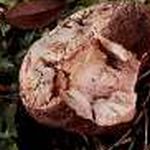| Common Name: |
Tuckahoe |
| Other Names: |
Indian Bread |
| Botanical Name: |
Wolfiporia cocos syn. Poria cocos, Sclerotium cocos |
| Genus: |
Wolfiporia |
| Family: |
Polyporaceae |
| Cultivation and Propagation: |
Information is not available on Chinese techniques for cultivation. |
| Harvest: |
Fungi are collected in winter and dried for decoctions and tinctures |
| Height: |
5-15cm (2-6in) |
| Width: |
10-30cm (4-12in) |
| Hardiness: |
Z5-9 |
| Parts Used: |
Whole plant (fu ling) |
| Properties: |
A sweet, sedative herb that is diuretic, regulates fluid metabolism and calms the heart energy. |
| Medicinal Uses: |
Internally for palpitations, insomnia, emotional disturbances, abdominal bloating, urinary dysfunction, and diarrhea. Used in many classic Chinese formulas, such as si jun zi tang ("soup of four noble things"), combining W. cocos with Atractylodes macrocephala (See, Chinese Thistle), Glycyrrhiza uralensis (See, Chinese Licorice), and Panax ginseng (See, Ginseng). |
| Bibliography: |
The Encyclopedia or Herbs by Deni Bown Copyright © 1995, 2001 Dorling Kindersley Limited. pg. 408 |

